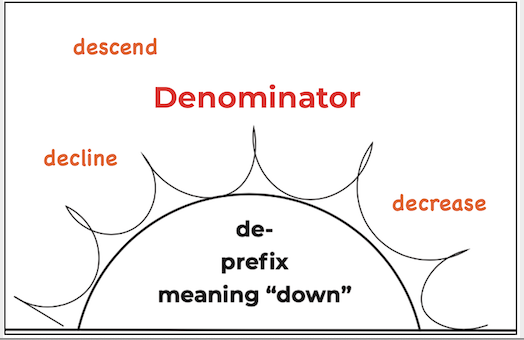
Teaching academic vocabulary is essential in order for students to understand the related content.
For example, look at the word ‘denominator.’ In this case, the prefix DE means ‘down.’ Students can relate this idea to other words in which the prefix DE means down. Related words include: describe – to scribble down, decelerate – to slow down, or denote – to to mark down.
Knowing the structure of academic vocabulary will help introduce students to new ideas and concepts. The familiar DE prefix used in the term ‘dehydration’ adds the idea of bringing down the level of hydration. From their very first encounter with academic terms with the prefix DE, they will have a clue as to the meaning. For example, when students first encounter the term ‘deionization’ they may have no idea what ‘ionization’ means, but they know that something will go ‘down’ (in the case of deionization, it’s the number of ions).
These types of verbal clues give students an advantage as they build their understanding of the new academic content and vocabulary. This is one of the reasons why vocabulary IS content.
Challenge your students to use their understanding of vocabulary to:
- Create a more detailed and nuanced understanding of the concepts they study.
- Make more connections between concepts.
- As an introduction to new ideas.
- Talk about the ideas with precision.
- Ask more detailed questions.
- Understand detailed answers to those questions.
- Translate the academic terms into everyday language.
- Translate everyday language back into academic language.
- Translate academic terms into mathematical symbols.
- Translate mathematical symbols into academic and everyday language.
- Explain how mathematical models show the concepts (verbally and in writing).
- Comprehend mathematical texts more easily.
- Think up concrete examples that demonstrate mathematical concepts.
- Develop number sense, making personal friendships with every number they meet (like Ramanujan).
Share This Story, Choose Your Platform!
Download Colorful Collections:
A Mindful Exploration of Proper Fractions
Help your students make sense of fractions.
I started teaching in 1987, which means I’ve collected many tips and tricks along the way. In this ebook, I share concepts, strategies, and classroom materials to help you make math sticky.
Along with this useful ebook, you will receive weekly emails from StickyMath@UnCommon-Core.com. I send information like: teacher tips, educational ideas, book reviews, curated lists, reviews of educational sites, and free first drafts of products that I’m creating for my TPT store. That way, you get helpful ideas and free stuff, while I get some feedback before I finalize products and put them up for sale.
I value your privacy. I will never sell your information. You may unsubscribe at any time.
All the best!
Isabelle
Isabelle Hoag M. Ed.

